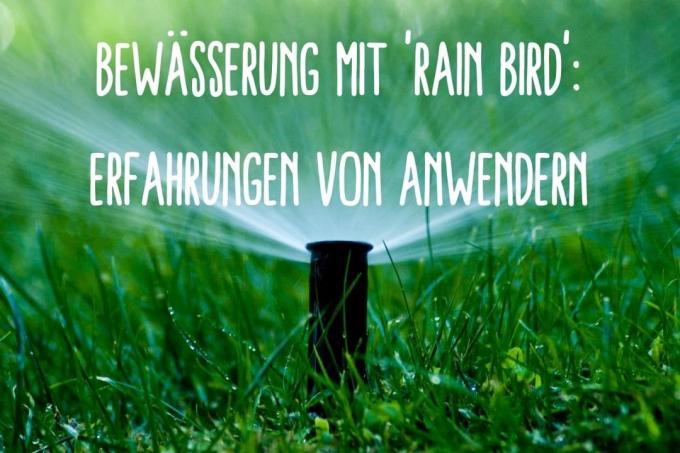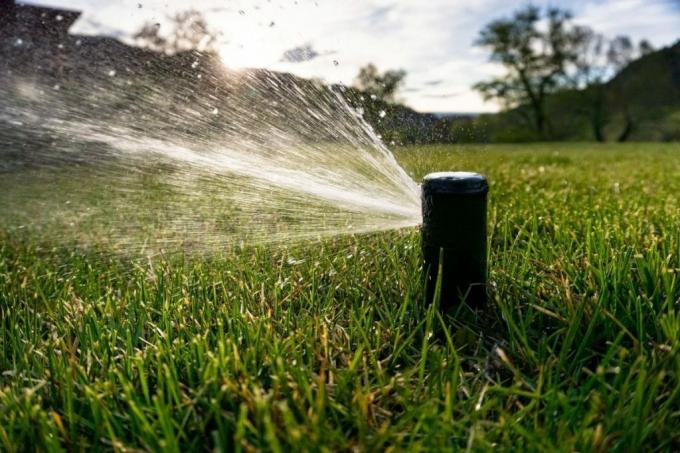
table of contents
- Function at a glance
- Use in the garden
- frequently asked Questions
- Experiences with 'Rain Bird'
Rain Bird is a Irrigation system of the company of the same name from the USA for professional or private use. The irrigation can be adapted to your own garden using individual components.
In a nutshell
- Rainbird makes automatic irrigation systems that can be used in the garden
- the systems can be adapted to the characteristics of the garden
- Components include control units, sprinklers, and more
- the installation can be carried out by a professional or on your own
Function at a glance
Using Rain Bird irrigation in your own garden is a good idea if you don't have the time for this work or if you don't have a large piece of land. It is not for nothing that the products are often offered for sports surfaces, including golf or soccer fields. The focus of this system is on the fully automatic mode of operation, which has several advantages:

- optimized water consumption
- thereby lower water costs
- System expandable with components
- less time required for maintenance
At the heart of Rain Bird's irrigation systems are the controllers and sensors. This can be used to set exactly how long and with what intensity. Depending on the system selected, it has sensors that set the water consumption and the duration more precisely. This will prevent one of the biggest problems in your garden: overwatering. If you turn on conventional systems for irrigation yourself, overwatering can quickly occur, which has a negative effect on the soil and the vitality of the plants. Rain Bird has specifically addressed this irrigation problem.
Note: Control units from other manufacturers cannot be combined with Rain Bird systems. In this case you have to switch completely to the new irrigation.
Use in the garden
Once you have chosen to water with Rain Bird, planning is especially important. In the garden in particular, it is necessary to select the right components that the irrigation system uses. If, for example, a lawn with a classic shape is to be watered regularly, the standard equipment is ideal. A standard garden irrigation system includes the following components:
- Control unit
- Valves
- Lawn sprinkler
- Hoses
- optional: electric cable
You can easily install these components yourself if the ground has been loosened and the trenches for the pipes have been dug. The components mentioned are usually sufficient for use in the garden. However, if you still need to customize the system more precisely, you can add the following items available from Rain Bird:

- Submerged nozzles
- different nozzles
- Rain sensors
- Soil moisture sensor
- Frost sensor
You should also take a look at the manufacturer's micro irrigation if you have drip irrigation in mind.
Tip: The irrigation system is laid at a depth of 30 to 40 centimeters. Note the slope of the floor and adjust the depth accordingly so that the pipes are not directly below the surface.
frequently asked Questions
In order to use the Rain Bird, you must accept regular maintenance. The timer must be checked every month and adjusted as required. On the other hand, it is important to clean the individual components each season. Especially the warheads are meant, as they can clog. The cables should also be checked for damage.
The use of a filter is not required for using the system, but the manufacturer recommends it. Especially in regions with hard water, a filter protects against limescale deposits that could clog the pipes and warheads with limescale deposits. Micron filters (100) are suitable for the system.
No, the majority of Rain Bird systems available have timers that stop operating when it rains. As an option, already installed systems can be retrofitted with a corresponding component that takes on this function.
Experiences with 'Rain Bird'
Note: For reasons of better readability, small spelling errors (spaces, inverted letters, etc.) have been corrected in the quotations. The exact sources are linked under the specification of the respective forum.
"[...] 8 years ago we had an irrigation system installed and after extensive consultation we chose RainBird: 400 sqm garden, 3 circuits (two in the perennial bed and vegetable garden with sprinklers, one for the lawn with recessed Sprinklers). [...] So far there have been NO problems with the system itself, really! What you have to replace is one or the other above-ground sprinkler (you step on it in summer, when everything is overgrown, and then he can break off), but you can do that without any problems, even if you are not particularly skilled at hand, change. The laying of new connections or additional circuits (we also did it ourselves) is easy; the thick hose lines still show no "signs of fatigue", […] To cut a long story short - I've known RainBird for 8 years from my own experience, so I can safely recommend it to others. […]“
Source: www.mein-schoener-garten.de User: pallida, 07/29/2008
“I currently have Rainbird and I am satisfied. Planning done by yourself. But unfortunately I was too inexperienced and relied on the information in the brochure for throwing distances, which is unfortunately not achieved. In addition, for reasons of cost and effort, I did not plan such a large overlap, which had the effect that the entire area was not watered. Then I partially used the pop-up sprinklers against other models or Longer range nozzles replaced. For the new house or Garden I will probably use Rainbird again, but now I already know what to watch out for when planning. […]
Source: www.energiesparhaus.at User: erwinh, 06/25/2019
"[...] have had good experiences with Rainbird. That stuff is expensive, I know. But the quality is right!
Source: www.knx-user-forum.de User: Bad Smiley, 03/28/2012

